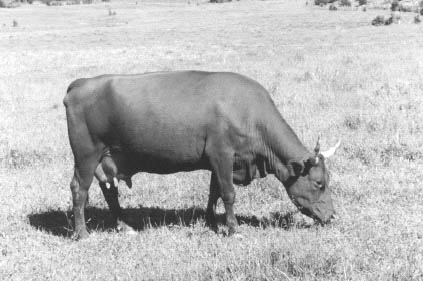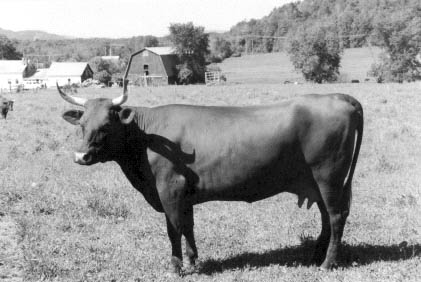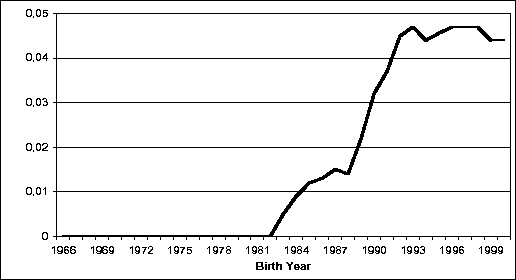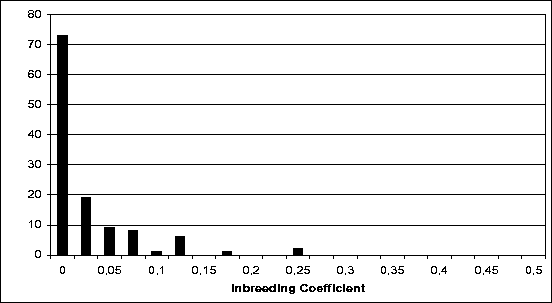Virginia Polytechnic Institute and State University, 3450 Litton Reaves Hall, Blacksburg, VA 24061, USA
Summary
The American Milking Devon Association was established in 1978 to record and preserve a unique type of cattle originally developed in the United States in the 17thcentury from imported English and contemporary American stocks. Phenotypically, it exhibits a spectrum of red colour, with light-coloured curved horns and medium body size. The breed is one of the few remaining triple-purpose breeds in the United States, and has been selected by breeders since colonial times for excellent temperament and powerful draught ability, along with desirable dairy and beef characteristics. It is well adapted to low-input management schemes and harsh environments. The American Milking Devon is currently found on the ‘critical’ list of the American Livestock Breeds Conservancy, indicating that there are fewer than 200 new registrations annually. Since the inception of the American Milking Devon Association, a small group of dedicated breeders has done much to preserve these cattle. However, new management tools are now being introduced to assist breeders and allow conservation of genetic diversity while retaining the original breed traits in terms of size, colour, beef and dairy production, and character and working ability.
Resumen
La asociación American Milking Devon fue establecida en 1978 para controlar y preservar un tipo único de bovino que se desarrolló de forma natural en EE.UU. en el siglo 17 a partir de razas inglesas importadas y efectivos existentes en América en aquella época.
Desde el punto de vista fenotípico, muestra un color rojo en toda su gama, con cuernos ligeramente curvados y con color y un tamaño corporal medio. La raza es una de las pocas a triple uso que quedan en EE.UU., y ha sido seleccionada por los ganaderos desde los tiempos coloniales gracias a su excelente temperamento y su habilidad de tiro, además de su aptitud lechera y de carne. La raza está bien adaptada a los esquemas de manejo con bajos entrantes y entorno dificil. Esta raza se encuentra actualmente en la lista crítica del American Livestock Breeds Conservancy, lo que indica que existen menos de 200 nuevas inscripciones anuales. Desde el principio, la asociación, formada por un reducido grupo de ganaderos, ha hecho lo posible por preservar la raza. Sin embargo, se han introducido nuevos métodos de manejo para asistir a los ganaderos y permitir una conservación de la diversidad genética manteniendo siempre los rasgos originales de la raza en términos de tamaño, color, y producción de carne y leche, así como su aptitud para el tiro.
Key words: American Devon cattle, Triple-purpose cattle, Genetic management.
Introduction
In 1623, a bull and two heifers were imported to the Plymouth colony in the United States from the county of Devon in southern England. These cattle, along with other purebred Devon cattle imported during the late 18th and early 19th century, and existing American stocks, formed the basis of the American Devon breed of cattle. The breed was very popular in the Eastern United States, and valued as a versatile, multipurpose breed. It was able to survive well on poor native forage and was a celebrated draught animal, with excellent milk for cheese-making and finely-marbled carcasses. In the late 1800’s, the American Devon Cattle Club was established, and importation of Devon cattle from England continued. During the mid 20th century, however, the breed faced pressure to specialize as a beef animal. A small group of breeders disagreed with this trend and founded a separate organization to preserve dairy and draught traits in their cattle. Although this organization later disbanded, many of the genetic stocks were saved and in 1978 the American Milking Devon Association was formed to record and conserve the original, colonial-type cattle.
American Milking Devon cattle are generally medium-framed (cows 400 kg to 500 kg; bulls 500 kg to 590 kg), red in colour and have light-coloured, curving horns of medium length with dark tips (Figures 1 and2). Females typically have very low calving difficulty and produce an average annual milk yield of 5500 kg (Felius, 1995). They are docile in temperament and excellent draught animals.
Pedigree Characterization
Herdbook records of 1310 cattle were utilized for the genetic characterization of the breed, entered directly from the American Milking Devon Record from cattle registered through December, 2000. To determine current living stocks and the available breeding population, all owners of cattle registered with the American Milking Devon Association were surveyed as to the status of their animals. From this census, it was determined that the current breeding population consists of 611 cattle (119 bulls and 492 cows).
Figure 1. An American milking Devon cow, grazing in its environment.

Figure 2. American Milking Devon with its curving horns of medium length with dark tips.

The average inbreeding in the current breeding population is 4.37%. While this is relatively low compared to most domestic breeds of livestock, it has doubtlessly been underestimated, due to incomplete pedigree information on foundation animals and certain contemporary cattle in the population. Incorporating a greater volume of pedigree data would undoubtedly raise the inbreeding level, though the extent to which the level would rise is unknown. Figure 3 illustrates the trend in inbreeding over time for the breed.
Individual inbreeding coefficients were generally higher in cows than in bulls in the current breeding population. The highest inbreeding level for bulls was 26.56%, while the highest inbreeding level for cows was 42.75%. Figures 4 and 5 display individual inbreeding coefficients for males and females.
Mean kinship describes an individual’s relationship to the rest of the breeding population, including itself. Two animals may have identical inbreeding coefficients, but the one with lower mean kinship is less related to the population as a whole, and will have greater allelic retention. Mean kinship can be an important indicator of genetic ‘usefulness’ when determining which animals should be considered for breeding or germplasm conservation. Selection of parents based on mean kinship has been shown to be a better strategy for genetic conservation than simply minimizing inbreeding over time in many captive populations (Lacy, 1995). Average mean kinship for the American Milking Devon breeding population is0.0324, while individual mean kinships range from 0.0112 to 0.0558 for bulls and from 0.0008 to 0.0528 for cows.
Figure 3. Inbreeding over time for the American Milking Devon.

Figure 4. Inbreeding for bulls in current breeding population.

The current breeding population can be traced to 133 founders (55 male, 78 female), with founder animals defined as those that cannot be traced farther back in their pedigree. Most foundation animals are represented by less than 100 living descendants, while a small number of founders (four bulls, five cows) are found in the pedigrees of more than 400 cattle currently in the breeding population.
Figure 5. Inbreeding for cows in current breeding population.

Patrilineal contribution can be used to measure founder effects. In the current breeding population, all animals trace to one of five foundation sires through their paternal line of decent. One foundation bull in particular is found in nearly half the current sires available in the breed. While this is not detrimental in a genetic sense, it does reflect the loss of foundation animals over time. This decline of foundation sirelines over time is common in most populations (Cunningham et al., 2001).
Large genetic contribution by a few prominent founders is expected in closed livestock breeds under selection (McPhee and Wright, 1925). However, when only a small number of founders have a large impact on a breed, there will be some loss of genetic diversity. Unequal founder contributions and loss of genetic diversity can be measured using founder genome equivalents, which simply reflect the number of founders needed, if represented equally, to produce the same amount of genetic diversity currently observed in the breeding population (Lacy,1995). The current number of founder genome equivalents in the American Milking Devon is 15.41, with potential founder genome equivalents of 57.41, indicating that equalization of founder animals may slow the loss of genetic diversity without having to introduce new stock or ‘grade up’ cattle.
Breeding Management
No one conservation system will work for all breeds (Wooliams and Meuwissen, 1999). The American Milking Devon Association recognizes their need for guidance in planning a conservation strategy tailored to their current population, breeding goals and time horizon. Although a long-term solution is not yet fully in effect, a technical support system is currently in place to assist breeders of American Milking Devon Cattle in their selection and mating decisions, and to provide advice to both breed representatives and conservation groups regarding the collection and storage of germplasm. Selection of genetically noteworthy bulls or mating pairs is accomplished by balancing the diversity indicators of inbreeding, mean kinship and founder genome equivalents with the traditional breeding goals of draught power, excellent dairying ability and improved carcass traits. This integrated approach to genetic management allows breeders to confidently achieve genetic progress while minimizing reduction of genetic variance.
Conclusion
The American Milking Devon is a unique, endangered breed of cattle developed in the United States from local and imported English stocks during colonial times. Current numbers are low and pedigree data is incomplete in the breed, thus obscuring reliable estimates of inbreeding and relationship among animals. Nevertheless, concerned breeders and hobbyists realize genetic diversity may diminish to critical levels if thoughtful breeding practices are not established and germplasm is not conserved. Current efforts to characterize the population genetically and offer technical assistance to breeders of American Milking Devons are necessary steps to help the triple-purpose cattle breed retain sufficient genetic diversity.
References
Cunningham, E. P., J.J. Dooley, R.K.Splan & D.G. Bradley. 2001. Microsatellite diversity, pedigree relatedness and contributions of founder lineages to thoroughbred horses. Animal Genetics 32, 360-364.
Felius, M. 1995. Cattle breeds: An encyclopedia. Misset uitgeverij bv. Doetinchem, Netherlands, pp. 690.
Lacy, R.C. 1995. Clarification of genetic terms and their use in the management of captive populations. Zoo Biology 14, 565-577.
McPhee, H.C. & S. Wright. 1925. Mendelian analysis of the pure breeds of livestock. III. The Shorthorns. J. Heredity 16, 205-215.
Wooliams, J.A. & T.H.E. Meuwissen. 1999. Development of an expert system for conservation. In J.K. Oldenbroek (Ed.), Genebanks and the conservation of farm animal genetic resources. DLO Institute for Animal Science and Health, Lelystad, Netherlands, 113-119.